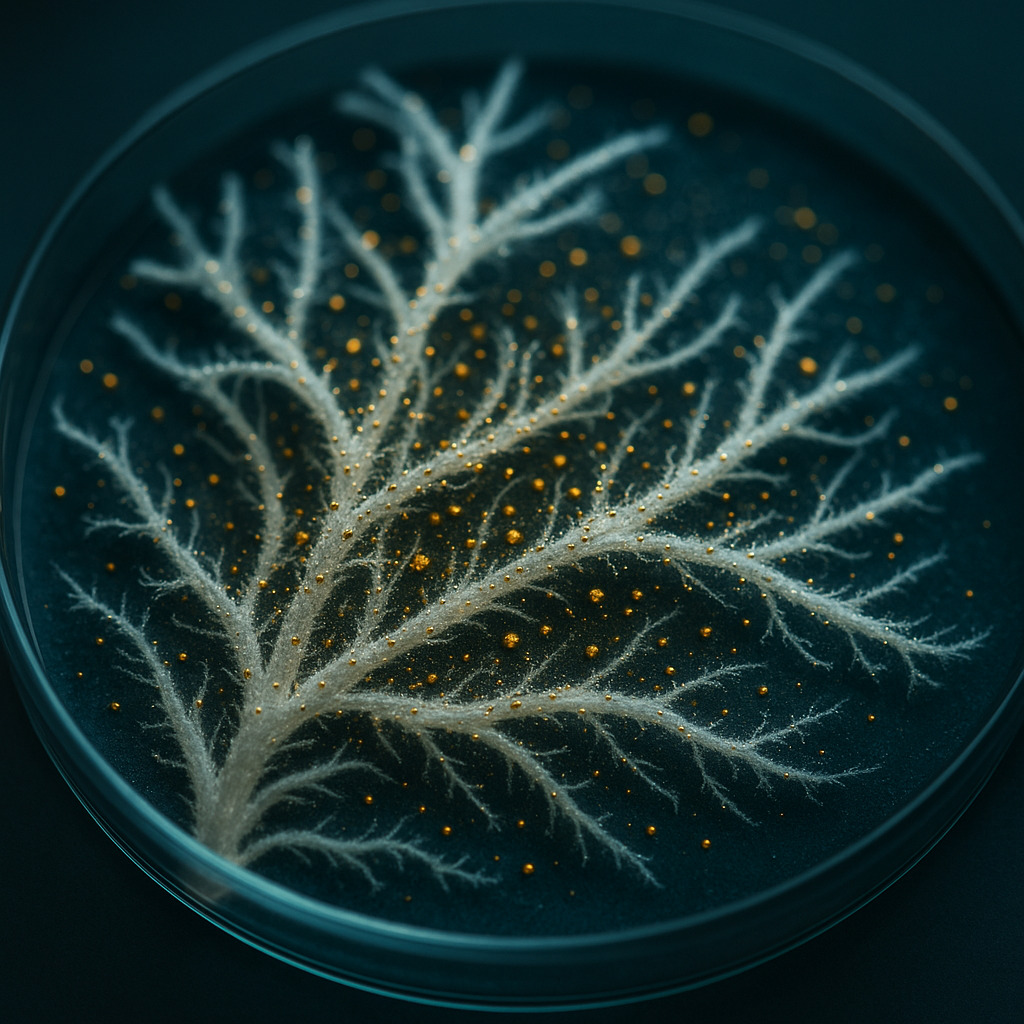The Fungus that “Creates” Gold? What Science Really Says
Sensational headlines recently hailed the discovery of a gold-eating fungus said to “create gold.” The idea calls to mind ancient alchemical legends: a living organism that transmutes ordinary matter into precious metal. But what is the real story? In this post we unpack the peer-reviewed science and explain why, though it is not magic, we may be looking at a breakthrough for sustainable mining.
The 2019 Australian discovery
In 2019 a team at the Commonwealth Scientific and Industrial Research Organisation (CSIRO) in Australia isolated from gold-rich soils in Victoria a strain of the fungus Fusarium oxysporum with a striking trick: when it grows in the presence of trace amounts of gold, its mycelium becomes coated with shimmering gold nanoparticles.
Electron-microscopy images show glittering filaments, as if the fungus were wearing a microscopic suit of armour. The paper—published in Nature Communications—provided solid evidence of a biological gold extraction pathway: normally inert metallic gold can be dissolved, transported and re-deposited thanks to microbial chemistry.
How the “gold-eating fungus” works
- Oxidation – The fungus secretes oxidising agents (peroxides and organic acids) that convert elemental gold into soluble ions (Au3+).
- Transport and reduction – Extracellular enzymes and polysaccharides capture the ions and reduce them back to Au0, but now as gold nanoparticles.
- Growth boost – The gold coating seems to accelerate fungal growth, perhaps by attracting nutrients or protecting the cell wall.
The amounts involved are minuscule: nano- to micro-grams per gram of biomass. Yet the process runs at room temperature, in water and without toxic reagents—unlike cyanide or mercury leaching used in conventional bio-mining.
Why it is NOT alchemy
The fungus does not create new gold atoms. It only operates where gold already exists, even in very low concentrations.
In other words, Fusarium oxysporum is a biological refiner, not an alchemist. Elemental transmutation requires nuclear reactions far beyond any living organism (and our wallets).
Potential applications
| Use | Potential advantages | Remaining challenges |
|---|---|---|
| Biomonitoring of deposits | Gold-eating fungus could indicate hidden veins without drilling. | Calibrate sensitivity in different soils; avoid false positives. |
| Bio-mining of low-grade ores | Low-energy, no cyanide/mercury. | Low yield; large biomass and long processing times. |
| Recovery of gold from e-waste | Treat end-of-life boards with fewer emissions. | Industrial scale-up; separating gold from other precious metals. |
| Extraction on asteroids or extreme environments | Less chemical payload to launch into space. | Little data on fungal growth in micro-gravity and cosmic radiation. |
State of the art (June 2025)
- Multiple groups from Europe to Japan are replicating CSIRO experiments, isolating fungi and bacteria that perform similar tricks on platinum, palladium and copper.
- Several pilot plants (kilogram scale) are testing biological gold extraction from electronic waste, but there is no commercial ton-scale production yet.
- The buzzword is mycomining: using fungi as living mini-refineries in a circular economy for precious metals.
The lure of a fungus that “turns everything into gold” belongs to fairy tales. The reality is almost as fascinating: biology offers a gentler way to concentrate a metal crucial to microchips, catalysts and finance.
If researchers overcome current yield and cost limits we may see a small revolution: less invasive mines, recycled e-waste, and one day perhaps extraterrestrial sustainable mining.
Until then, enjoy the story of a gold-eating fungus that—without magic—reminds us how many elegant solutions nature still holds for engineering the future.








Leave a Comment